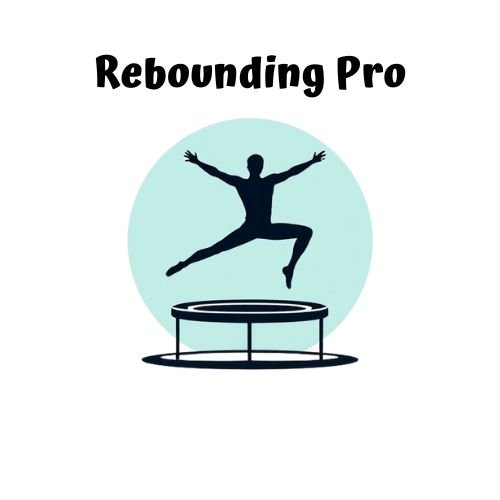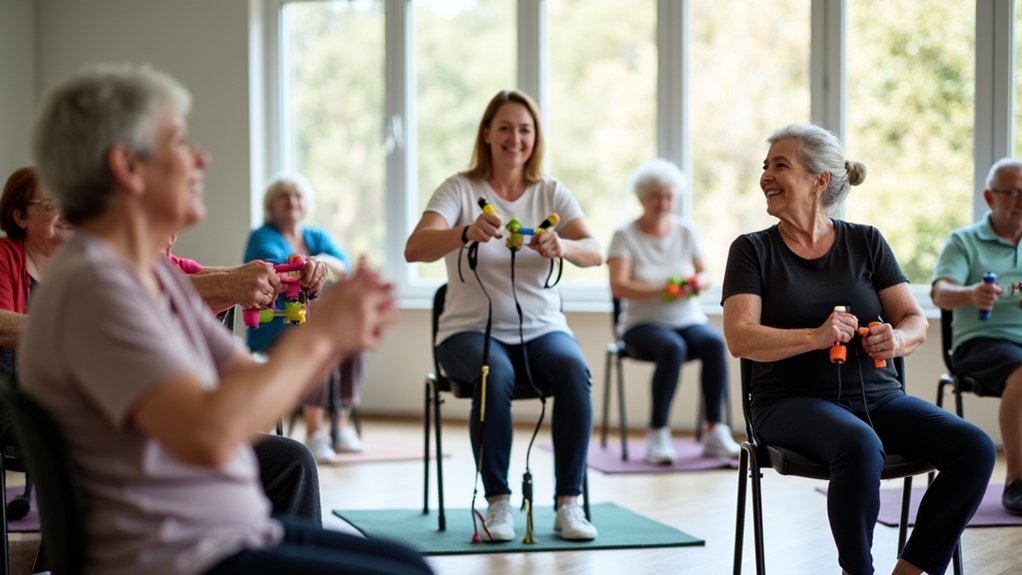Low-impact trampoline core exercises blend fun with effective muscle engagement while protecting your joints. Start with basic seated activations and side-to-side balance work before advancing to air bike crunches, twist jumps, and knee tucks. For maximum benefits, maintain proper form with feet hip-width apart and focus on bouncing down into the trampoline. These exercises engage your core more effectively than traditional floor workouts while reducing impact force by up to 80%. Continue for complete beginner-to-advanced progressions and safety tips.
Why Low Impact Trampoline Workouts Benefit Your Core

When you step onto a mini-trampoline for a workout, you’re engaging your core muscles in ways traditional floor exercises simply can’t match. The unstable surface immediately activates your abdominals, obliques, and lower back as they work to maintain your balance with each bounce.
Unlike high-impact exercises that stress your joints, trampolines absorb up to 80% of the impact force. This means you can train more frequently without overloading your body. Your core muscles continuously engage throughout the workout, stabilizing your trunk while your limbs move. Coach Ashley Wimoni’s Core Sculpt workout effectively targets these muscles through dynamic movements on the trampoline.
The best part? You’ll likely stick with these exercises because they’re genuinely fun. This enjoyment factor keeps you coming back, ensuring consistent core development while improving your balance, coordination, and cardiovascular health simultaneously.
The Science Behind Rebounding and Core Engagement
Your body experiences a gravitational shift during each rebound, forcing your core muscles to continuously stabilize against the changing forces.
This constant adjustment activates deep abdominal muscles through a process called reactive stabilization, where your body instinctively counters the trampoline’s unstable surface. This makes rebounding an excellent low-impact exercise for people of all ages who want to strengthen their core without stressing their joints.
Your brain’s proprioceptive awareness heightens on the trampoline, improving your spatial orientation and core muscle recruitment with every bounce.
Gravity’s Effect On Muscles
Although often overlooked, gravity plays a fundamental role in how our muscles develop strength and resilience during trampoline exercises. When you rebound, your body experiences varying G-forces that stress your cells, forcing them to adapt and become stronger.
This gravitational fluctuation—compression at the bottom of a bounce and near weightlessness at the top—creates an efficient workout environment where forces distribute evenly across your body. NASA studies confirm that rebounding helps mitigate bone loss in astronauts subjected to zero gravity environments.
- Cellular Response – Each bounce triggers your cells to strengthen through repeated acceleration and deceleration cycles
- Uniform Stimulation – G-forces spread evenly across ankles, knees, spine, and head, engaging muscles throughout your body
- Mitochondrial Boost – Controlled gravitational stress enhances your mitochondrial function, increasing cellular energy production
The absence of gravity leads to muscle loss, highlighting just how essential these forces are for maintaining strength.
Core Stabilization Mechanics
Core stabilization mechanics explain why trampoline workouts uniquely challenge your midsection. Each bounce activates your abdominal and lower back muscles as they work to maintain balance against the unstable surface and changing gravitational forces.
During rebounding, your body constantly adjusts to the dynamic environment, engaging neuromuscular coordination pathways that aren’t triggered during static exercises. This creates a natural core-strengthening effect where your muscles must stabilize your spine and pelvis with every movement.
The beauty of trampoline core training lies in its low-impact nature—you’ll strengthen your entire core while protecting your joints. A strong core significantly improves injury prevention and helps maintain proper posture during daily activities.
When performing exercises like Russian twists or boat poses on the trampoline, you’re creating rotational strength and functional stability that translates to improved posture and movement patterns in daily life.
Proprioception During Rebounds
Proprioception, often described as your body’s internal positioning system, plays an essential role during trampoline exercises. When you bounce, your body continuously receives sensory feedback as joint and muscle mechanoreceptors activate, enhancing your spatial awareness and core stability.
Your rebounding workout delivers powerful proprioceptive benefits:
- Enhanced neural pathways – Repeated bouncing strengthens connections between sensory receptors and motor responses, improving your balance reflexes.
- Multi-directional core engagement – The unstable surface forces your core to stabilize in all planes of movement, creating thorough strength. This dynamic environment supports whole body strengthening in a low-impact manner suitable for all fitness levels.
- Vestibular integration – Each bounce synchronizes your visual, balance, and position-sensing systems, developing better coordination for everyday movements.
This neurological training makes rebounding particularly effective for rehabilitation and fall prevention.
Essential Equipment for Safe Rebounding Core Exercises
Investing in a high-quality rebounder with proper weight capacity and durable steel construction will protect your joints while maximizing core engagement.
You’ll need at least 3-4 feet of clearance around your mini trampoline to perform exercises safely without obstruction.
For added stability, especially if you’re a beginner, consider models with adjustable safety bars that allow you to maintain balance while performing more challenging core movements.
Look for rebounders with high-quality materials like polypropylene mats that provide optimal stretch resistance and support during dynamic core workouts.
Quality Rebounders Matter
Three essential factors distinguish quality rebounders from inferior alternatives when selecting equipment for trampoline core exercises.
When focusing on abdominal and core workouts, stability features and surface characteristics directly impact your exercise effectiveness and safety. Maintaining proper knee alignment during rebounding exercises is crucial for preventing injuries while engaging your core muscles.
- Stability System – Look for adjustable legs that prevent wobbling during lateral movements and heavy-duty frames supporting at least 250 lbs to accommodate dynamic exercises without compromising structural integrity.
- Bounce Technology – High-quality springs or bungee cords should provide consistent resistance while absorbing up to 80% of impact shock, protecting your spine during repetitive movements.
- Surface Design – Premium rebounders feature 6-8mm thick, waterproof mats with non-slip surfaces to enhance grip during balance-focused routines and padded edges to prevent injuries during side-to-side movements.
Safety Bars Add Balance
Safety bars transform simple rebounding into effective and secure core training by stabilizing your entire workout experience. They provide essential support during squats, lunges, and dynamic movements while helping you maintain proper posture to protect your lower back.
You’ll notice improved core activation as the bars allow you to isolate abdominal muscles without overcompensating with your legs. They’re particularly valuable for beginners, reducing fall risks during lateral movements and quick shifts.
As you progress, gradually decrease your reliance—moving from a firm grip to light fingertip touch. The transitions from full support to independence mimics the approach seen in basic bounce progression exercises where participants slowly release the handlebar.
For advanced training, use the bars to expand your exercise range with deeper twists and controlled leans. They also enable seated or supine exercises like air bikes, where bar-assisted positioning maximizes core engagement while minimizing joint strain.
Beginner-Friendly Rebounding Core Movements

As you venture into trampoline-based fitness, mastering a few fundamental movements will establish the foundation for your core-strengthening journey. Start with basic bounce stabilization, keeping your feet hip-width apart and knees aligned over hips while controlling your downward push into the rebounder surface. Remember to focus on bouncing down into the trampoline rather than jumping high for effective core engagement.
- Seated Core Activation – Try the partial-sit position with hands behind thighs for isometric abdominal engagement without spine compression.
- Side-to-Side Balance Work – Practice lateral weight transfers with a 2-inch travel range, adding counterarm movements to enhance oblique activation.
- Single-Leg Stability Drills – Hold 10-second unilateral stances with arms outstretched, then progress to gentle micro-bounces while maintaining balance on one leg.
Intermediate Rebounding Exercises for Core Strength
Once you’ve mastered the basics, you’re ready to challenge your core with more dynamic rebounding exercises.
Try air bike crunches by lying on your rebounder and alternating knees to elbows for deeper core engagement.
Jump and tuck exercises target your abs as you bring your knees to your chest while jumping. For an added challenge, incorporate twist jumps that engage your obliques while maintaining balance.
Engage your entire core with dynamic tuck jumps, then level up with twisting variations for maximum oblique activation and stability training.
Trampoline crunches intensify traditional ab work on an unstable surface.
Boost intensity by adding ankle weights (2-3 lbs) or integrating interval training with alternating knee lifts during bounces. Consider a format of 40 seconds jumping followed by a brief 10-second transition to core exercises for an efficient workout structure.
These exercises not only strengthen your core but also improve hip mobility and flexibility while providing excellent calorie-burning benefits.
You’ll notice enhanced coordination as you progress through these controlled, purposeful movements.
Advanced Core-Focused Rebounding Techniques

You’ll take your core workout to the next level with rotational power moves that challenge your obliques and improve spinal mobility.
As your stability improves, incorporate balance progression training by reducing your base of support or closing your eyes during rebounds. For optimal core engagement, try performing the “Wipers” exercise where you create twists from the hips with either bent or straight legs to intensify the workout.
These advanced techniques maximize core engagement while maintaining the low-impact benefits of trampoline exercise.
Rotational Power Moves
Taking your trampoline workout to the next level, rotational power moves transform simple bouncing into a thorough core challenge.
These techniques leverage the trampoline’s rebounding energy while engaging your obliques, transverse abdominals, and deep stabilizing muscles through controlled rotation. The low-impact nature of rebounding allows you to perform these challenging core exercises without putting stress on your joints.
- Surf Twist – Keep your shoulders square while rotating your hips and feet, creating opposing forces that intensely activate your core’s rotational fibers.
- Twisted Bounce – Jump and rotate your torso 90 degrees mid-air, landing with control before rebounding into the opposite direction.
- Momentum-Driven Twists – Combine forward jumps with alternating torso rotations while using counterbalancing arm movements to maximize oblique engagement.
For safety, maintain a neutral spine throughout all rotational movements and start with smaller 45-60 degree rotations before advancing to fuller twists.
Balance Progression Training
While mastering basic bouncing techniques creates a foundation, balance progression training elevates your trampoline workout into a thorough core stability challenge.
Start with a one-legged stance, gradually shifting your weight onto one leg while keeping the other foot lightly touching the surface. Make certain your stabilizing muscles remain engaged throughout each movement.
As you progress, incorporate dynamic arm movements to further challenge your balance. For optimal results, try alternating knee-to-chest movements followed by straight leg kicks to engage tiny stabilizer muscles while maintaining balance.
Try holding static positions for several seconds, testing both your balance and core strength. You’ll notice your stabilizers working overtime as the trampoline’s unstable surface intensifies each exercise.
Gradually increase difficulty by adding slight bounces while maintaining your single-leg position, or incorporate weight shifts between legs to develop extensive balance control.
Mini-Trampoline Core Circuits for Maximum Results
Three key elements create truly effective mini-trampoline core circuits: proper exercise selection, strategic circuit structure, and consistent intensity management.
By combining exercises like air bikes, v-ups, and planks with HIIT principles, you’ll maximize core engagement while burning calories efficiently.
Fuse dynamic core moves with interval training to maximize abdominal activation while torching calories in minimal time.
For ideal results, structure your workout with:
- Two-Round Circuit – Complete 40 seconds of each core exercise (twists, crunches, jump and tucks) followed by 10 seconds rest, then repeat the entire sequence.
- Progressive Intensity – Start with simpler moves like basic bounces, then advance to tabletop positions and roll-ups.
- Breath Control – Synchronize your breathing with each movement, exhaling during the most challenging portion to activate your core fully.
This time-efficient approach delivers both strengthening and cardio benefits without high-impact strain. Consider incorporating the dead bug position exercise with arms up and alternating limb reaches for enhanced core stability.
Using Accessories to Enhance Core Rebounding Workouts
To maximize your mini-trampoline workouts, incorporating specialized accessories can transform basic bouncing into thorough core training.
Resistance bands anchored to the frame add tension during seated marches and Russian twists, while adjustable resistance levels enable progressive overload.
Stabilizing handlebars positioned at 30-40 inches support proper form during knee lifts and even allow for rebounding push-ups. JumpSport offers handle bars and accessories that provide additional support while enhancing safety during dynamic movements.
For advanced training, plyometric boards create explosive power development through tuck jumps and lateral bounds.
Choose rebounders with impact-reduction features like arched legs and EnduroLast cords to protect joints during high-intensity sequences.
The most effective routines combine multiple accessories—pair resistance bands with handlebar support for standing crunch-pulls or sequence plank holds with rebounding knee-ins for thorough core engagement.
Proper Form and Technique for Core Rebounding
Mastering proper form transforms every bounce on your mini-trampoline into an effective core-strengthening movement.
You’ll maximize results while minimizing injury risk by maintaining centered weight distribution and proper knee alignment over your hips. Keep your core engaged throughout each exercise to improve stability and amplify the workout’s effectiveness.
- Maintain proper breathing – Inhale as you lower into the bounce and exhale as you rise up to stabilize your heart rate and enhance endurance.
- Control your range of motion – Adjust how deeply you bounce based on your fitness level and comfort.
- Focus on momentum control – Learn to harness the trampoline’s rebound effect rather than fighting against it for smoother shifts between movements.
Creating a Progressive Core Rebounding Routine
Building an effective core rebounding routine requires strategic progression that evolves with your fitness level. Start with basic bouncing to establish balance, then incorporate exercises like air bike crunches and scissors as your confidence grows.
| Level | Core Focus | Duration |
|---|---|---|
| Beginner | Basic bouncing, assisted jump and tuck | 10-15 min |
| Intermediate | Air bike crunches, scissors with arm movements | 15-20 min |
| Advanced | Weighted anchors, bouncing with twists | 20-30 min |
Customize your routine by evaluating your needs and gradually increasing intensity. Implement HIIT intervals to boost cardio benefits while maintaining core engagement. Remember to maintain proper posture and breathing techniques throughout. As you progress, speed up shifts between exercises and extend workout durations to continually challenge your core strength.
Nutritional Support for Rebounding Core Workouts
Proper nutrition plays an essential role in maximizing the benefits of your trampoline core workouts. Focus on hydration before and during sessions, consuming protein for muscle repair, and balancing complex carbs for sustained energy throughout your rebounding exercises.
For ideal results, time your nutrition strategically:
- Consume a balanced meal 1-2 hours pre-workout and hydrate 30 minutes before jumping.
- Replenish with a protein-rich snack within 45 minutes post-workout to support muscle recovery.
- Include omega-3 fatty acids, magnesium, and antioxidants in your daily diet to reduce inflammation and protect muscles from exercise-induced stress.
Regular rebounder sessions can significantly enhance your lymphatic drainage capabilities when combined with proper nutrition. Don’t overlook supplements like BCAAs and creatine if you’re pursuing intense core training—they can markedly enhance your strength gains and recovery time.
Preventing Injuries During Trampoline Core Training
While rebounding offers a joint-friendly workout alternative, safety must remain your top priority during trampoline core training. Always check your equipment before each session, ensuring springs are intact and the mat is free from tears.
Begin with basic health bounces where your feet don’t leave the mat, gradually progressing to more dynamic movements once you’ve built foundational stability. Maintain proper alignment by keeping your spine neutral, core engaged, and knees slightly bent to absorb impact.
Don’t attempt advanced moves like flips before mastering basics. Wear supportive footwear with non-slip soles, and position your trampoline away from furniture or sharp objects. Using a trampoline designed with safety features like padding and netting significantly reduces injury risk.
Remember to incorporate pre-workout dynamic stretches to prepare your muscles, and stop immediately if you experience pain or dizziness.
Tracking Progress in Your Rebounding Core Journey
Now that you’ve established safe exercise habits, let’s focus on how you’ll measure your rebounding success. Tracking your journey isn’t just motivating—it’s essential for adjusting your routine as your fitness improves.
1. Record quantifiable metrics – Keep workout logs documenting exercises, repetitions, and duration.
Take weekly measurements and progress photos to visualize changes that mightn’t be apparent on the scale.
2. Monitor qualitative improvements – Pay attention to enhanced coordination, better posture, and reduced post-workout fatigue.
These indicators often precede visible physical changes. Studies have shown that mini trampolines provide remarkable improvements in balance and body composition that may not be immediately visible.
3. Leverage technology – Use fitness apps and wearables to track heart rate, calories burned, and workout consistency.
Record occasional sessions to review your form and technique improvements.
Set SMART goals and celebrate each milestone—remember, progress matters more than perfection.
Frequently Asked Questions
Can Rebounding Help Reduce Cellulite Appearance?
Yes, rebounding can help reduce cellulite appearance by improving circulation, strengthening muscles, and aiding fat loss. It’s not a specific cure, but you’ll see better results when you combine it with healthy eating.
How Long Should a Beginner’s Trampoline Core Workout Last?
Start with just 10-15 minutes for your beginner trampoline core workout. You’ll prevent muscle fatigue while allowing your balance system to adapt. Progress to 20 minutes after 2-3 weeks of consistent practice.
Is Rebounding Safe During Pregnancy?
You should consult your doctor before rebounding during pregnancy. While it can be safe with modifications like reduced bounce height and support rails, risks increase in later trimesters. Always prioritize balance and listen to your body.
Can Children Benefit From Core Trampoline Exercises?
Yes, your children can benefit greatly from core trampoline exercises. They’ll develop stronger abdominal muscles, improve balance, and build coordination while enjoying the fun bounce that makes exercise feel like play.
Does Trampoline Exercise Help With Posture Problems?
Yes, trampoline exercise helps your posture problems by strengthening core muscles, promoting spinal decompression, correcting muscle imbalances, and improving proprioception. You’ll develop better alignment through low-impact, symmetrical strengthening of postural muscles.
In Summary
You’ve now discovered the most effective low-impact trampoline exercises to strengthen your core while protecting your joints. By incorporating these movements into your regular routine, you’ll boost your stability, improve your posture, and enhance your overall fitness. Remember to start slowly, progress gradually, and listen to your body. With consistency and proper form, you’ll transform your core strength through the fun, efficient practice of rebounding.





Leave a Reply